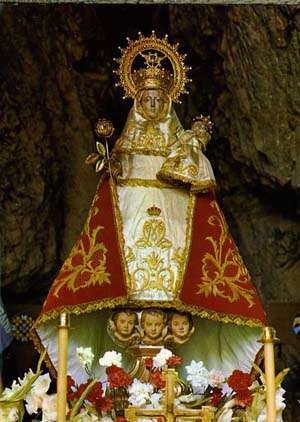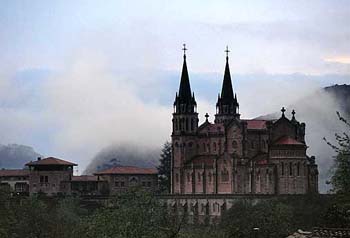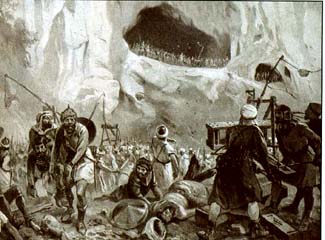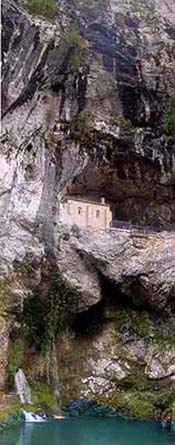Our Lady of Covadonga – September 7
Biographical selection:
In 711 the Muslim Arabs invaded the Iberian Peninsula. The Visigothic King Rodrigo died facing them in the Andalusian field of Guadalete in southern Spain. Taking a position of resistance against the rapid conquest and domination of the infidel, Don Pelayo led a group of valorous knights who had withdrawn to the northern mountains of the Asturias to recoup and fight.
In 711 the Muslim Arabs invaded the Iberian Peninsula. The Visigothic King Rodrigo died facing them in the Andalusian field of Guadalete in southern Spain. Taking a position of resistance against the rapid conquest and domination of the infidel, Don Pelayo led a group of valorous knights who had withdrawn to the northern mountains of the Asturias to recoup and fight.
 |
Don Pelayo prepared the resistance to meet the large Muslim army at Alzeba Mountain, where the cliffs offered an advantage to the greatly outnumbered Catholics. He placed his men strategically along the cliffs, and while they waited for the enemy to advance, he went to the nearby Cave of Covadonga, where he had placed a statue of Our Lady and asked for her special protection in the coming battle.
The Moors began the attack, sending arrows at the Catholic soldiers behind the stone cliffs. But already, at this first attack, something extraordinary happened: the arrows returned against the Moorish archers who had drawn the bows, killing them. A group of Catholics advanced to fight, while others shot arrows and threw stones and trunks from the Alzeba Mountain down over the enemy troops.
After a short while, Suleiman, the second in command, fell dead, disorder erupted in the army, and Alkamar gave the order to retreat.
At that moment a terrible storm broke out. Thunder roared, lightning lit the dark slopes, and heavy rain caused mudslides that sent boulders and trees tumbling down the mountain and falling over the retreating Arab troops. Struggling in the mud, many Moorish soldiers slipped and fell into the Deva River, where they drowned. The Holy Virgin made the mountain itself fall over the soldiers of Muhammad.
 |
It was later replaced by a great Basilica that was consecrated in 1901.
Even Arabian historians refer to this battle with astonishment, without hiding the enormous numbers of Muslims who died during it.
Comments of Prof. Plinio:
What is the lesson we can take from these facts?
You know the disproportion between the size of the armies and the means in our battles against the Revolution. Here the selection also describes a great disproportion between the Spanish soldiers and the Muslim troops. From a natural perspective, the Catholics were completely lost. However, they did not give up. They did every possible thing they could to win, even though the victory seemed impossible. I insist on this formula: to do every possible thing to win an impossible victory.
 |
In this scenario, after they had done what was humanly possible, a series of miracles occurred. They were throwing stones and trunks from the mountains on top of the advancing enemies, as well as shooting arrows against them. Then, Our Lady intervened: she directed the arrows of the Moors to return against themselves. She sent a storm that made the boulders and trees from the mountain fall on top of the enemy hosts. Anyone who knows Spain has an idea of the violence of nature in that mountainous region and can picture a terrible storm with the swelling waters and ground rolling down the mountain cliffs into the valley. Most probably, the Catholics found refuge from the storm either in the Cave of Covadonga or other smaller mountain shelters. With those miraculous actions Our Lady won the battle.
 |
The lesson is that we should have a supernatural perspective to envisage our vocation and our fight. We must do whatever is necessary to win, even when it is impossible. Divine Providence does not ask us to be blind to reality. We must analyze the situation, and even when we see that it is impossible to win this or that battle, we must wage it anyway. We must desire what Divine Providence desires. We must believe in what is humanly unbelievable. We must be convinced that Our Lady is par excellence the Mother of the Impossible. She asks us to do what is impossible – she has the right to ask this of us – and she will come to achieve the victory, after we do everything we can.
The Moors took all of Spain without a serious reaction until Covadonga because they found tepid and mediocre Spanish Catholics, who only had arguments of good sense. They were resigned to do nothing except what was reasonable. So, they were defeated and Spain was conquered.
At the moment when some Catholics believed in the impossible under the protection of Our Lady, the game changed, and the Reconquista began. The Moors were defeated at Covandonga, but also they were potentially defeated in all Spain because of that mentality triggered at Covadonga. Many centuries would pass before the Moors were completely expelled in the 16th century. But the mentality which inspired the Reconquista was the same one that won in Covadonga: To believe in the impossible under the protection of the Virgin.
We should ask Our Lady for the grace to never doubt a victory that we are sure she wants – even if it seems impossible. We should do everything we can to achieve that goal and trust that she will give the final victory.
